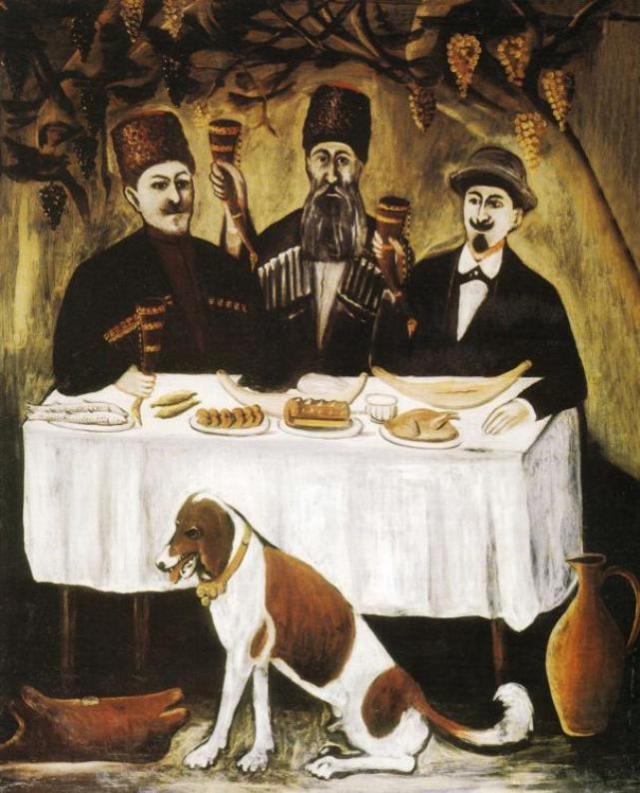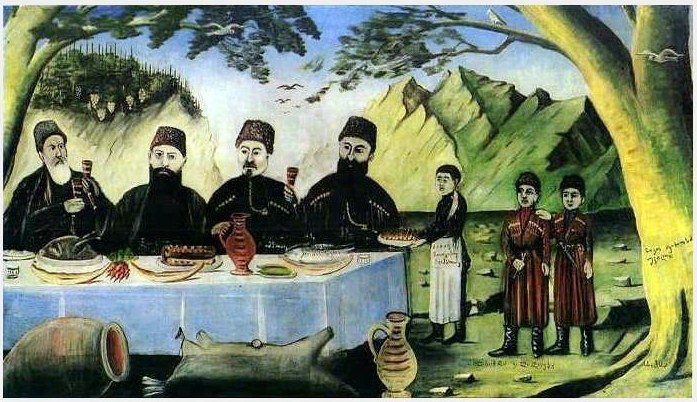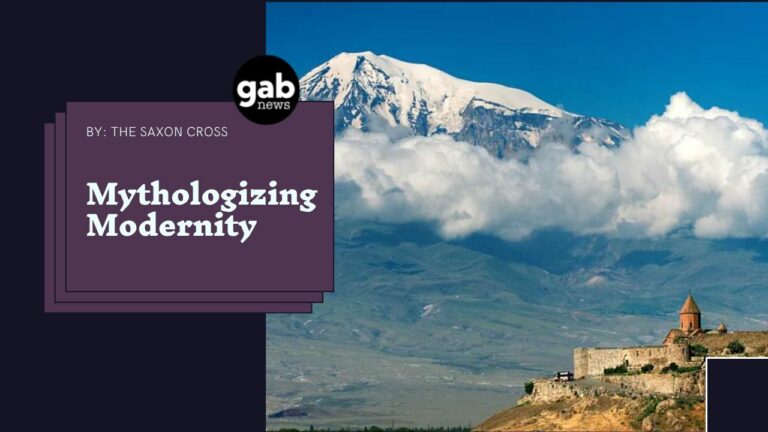The Supra is essentially a banquet feast in which the tamada, the toast master, leads the table through various themes by speaking words in the form of poetic toasts. The nature of the toasts, the food, and the embedded rituals of the Supra deeply reflect the ethos of Orthodox Christianity, the religion adopted by the nation in the 4th century. It is said that the Supra emerged from the ancient Agape feast, the early church tradition commemorating the Last Supper shared by Christ and his disciples.2 The Supra did not supplant the fundamental Christian ritual of the Divine Liturgy but should rather be understood as an overflowing of sacred liturgical life into the world. Therefore it is no coincidence that the traditional cosmic symbolism of Genesis permeates the Supra, and hence Georgian culture, even today. Like many traditional rituals, the Supra is a way for participants to be united in community, cultivate awareness of cosmic forces, partake in the beauty and wonder of the universe and recognize when created things fall out of line with their ultimate spiritual ends.
This essay will explore the cosmic symbolism of the Supra, using Matthieu Pageau’s commentary on the traditional cosmology of Genesis, The Language of Creation as a guide.
Wedged between Eastern Europe and Western Asia, high up in the Caucasus mountains sits the small country of Georgia.1 For 1700 years the Georgian people have managed to preserve their core identity, despite various foreign hegemonies, wars, and the travails of residing in a historically turbulent geopolitical locale. Sustained ritual is not the least reason for this remarkable cultural preservation. Unlike most contemporary methods of cultural expression (sensory entertainment) and social interaction (dominated by digital technology), the traditional ritual is both participative and unifying. The Georgian Supra is a hallmark of a coherent ritual that has passed through the tides of history up till this present day.
Supra as mediation between heaven and earth, meaning and material
A large, wooden rectangular table is arrayed with colorful food, steaming and delectable. The men gathered round, dressed in their finest clothes, eagerly await the commencement of the Supra. The murmuring of the table subsides as the tamada rises to make the first toast: to God.
The Supra can be understood primarily as a means of mediating between heaven and earth, or meaning and matter. The mediation takes place at multiple levels: individual, communal, and cosmic.
Perhaps the most obvious characteristic of the Supra is that it is a feast. The festal aspect is not accidental and sheds light on the mediation process occurring on the individual level. During a feast, food is ingested through the head, giving the body sustenance, which then gives power to the head by expressing its intentions. In traditional cosmology the heart is the mediating organ between the head (intentions) and the body parts (expressions). When the heart is purified and aligned with the rhythmic liturgical cycle of fasting and feasting, then the body follows by manifesting a higher reality.
The second level of mediation at the Supra is the communal level. At this level the words of the tamada during his toasts mediate between the intentions of the tamada and the participants. When the tamada properly asserts authority by making spiritual reality, or meaning, “ingestible” for those present, the table unites in support of the tamada, giving him their respect, and therefore power. The result is a group of individuals unified under a shared identity. One of the most important toasting themes, the “Mother of God” represents a type of meta-toast bringing this pattern of word and receptivity to consciousness: the Mother of God receives the Word of God from the Holy Spirit, gives flesh to the Word, and births the Word into existence. Such is the role of the participants.
At the cosmic level, each participant at the table, and particularly the tamada, is a mediator between heaven and earth. In fact, according to tradition the tamada symbolizes the person of Jesus Christ at the Last Supper who, as the Son of God, is the perfect mediator between heaven and earth.3 Humanity’s role as mediator, as Pageau explains is to “inform matter with meaning and express meaning with matter.”4 The symbolic nature of the Supra brings this process to fruition. For instance, wine at a Supra is more than simply its chemical composition; it is a symbol of blood (even Christ’s blood) shared by the participants who drink together after each toast. Wine, and those around the table, are thus elevated to a divine identity. It is man alone who can lower heaven (meaning) to inform matter (wine) and raise earth (wine) to express higher meaning (heaven). This is man’s role as cosmic mediator.

Perhaps the reason the Supra is so poetic is because these three levels of reality are constantly traversed in order to illuminate certain concepts. Similar to fairy tales and parables, Supra toasts do not stray from interchanging “man” with “heart,” or “heaven” with “seed,” or “family” with “body.” Anyone with the ability to effortlessly jump between and relate these cosmological categories will prove himself an adept toast giver.

Supra as attraction of grace by finding balance
You may have noticed that each method of mediation involves integration in some capacity: the body at the individual level, individuals at the communal level, and corporeal reality at the cosmic level. One function of the Supra, therefore, is to integrate. However, it ought to be noted that certain things are not worth integrating. For example, there is a taboo against mixing alcohols at a Supra. Everyone is expected to drink wine, an alcohol which unites the individuals. But to drink wine in addition to say, beer, is said to result in sickness and even communal disintegration. Another example is the fact that the toasting themes are limited. Because of the hierarchical nature of toast themes, beginning first with the highest possible principle (God), many themes are necessarily excluded. You will never hear a toast to paper towels, or uncle Georgi’s snoring problem. Certain things simply do not fit into the ritual, and if forced to integrate, would hinder the heaven/earth mediation and the cohesiveness of the ritual.
In traditional cosmology as outlined in The Language of Creation, when an established connection between heaven and earth exists, allowing for proper integration, the result is the phenomenological state of “space.” Symbolic imagery associated with the spatial axis includes things like the self-reproducing tree, the hierarchical mountain, a square or cube, and dry land. When the connection between heaven and earth is lost, the consequence is a state understood as “time.” Time, the force of transformation, may be represented by the stranger or outsider, the snake, the revolving circle, and chaotic water.5 Pageau explains, “In traditional cosmology, the patterns of space and time are mediators of knowledge that are synonymous with reason and absurdity… One is the principle of work and productivity, and the other is the principle of rest and recreation. In practice, following the artificial law of space leads to accumulation and stability, whereas following the natural law of time leads to waste and instability, but also re-creation and renewal.”6 The Supra incorporates several symbolic activities which clearly point to these categories of existence and attempt to navigate them in order to properly mediate between heaven and earth.

The Supra table is the most obvious symbol representing the spatial pattern: a table is stable, rectangular, wooden, and immovable. The table is imperative for a Supra. In fact, the word “Supra” in Georgian actually means tablecloth.
The toasts, the tamada, and the men at the table are further representations of the spatial axis. Common toasting themes are “God,” the “Mother of God,” “peace,” “women,” “men,” “death,” “life,” and “parents.” The method of toasting is patterned after the fractal-like structure of a tree, where the tamada names a branch and participants add to the branch by poetically speaking on the pattern, connecting the different levels of reality and thereby adding “flesh” to the self-reproducing branch. If the tamada introduces the theme of “parents” for example, one participant might tell a story of a time his father protected him, or show gratitude to his mother for bringing him into the world. On the same theme another might toast to the Georgian “motherland,” the soil in which he was “planted” and given life. In this way, “parents” becomes a symbol that gathers participants’ different experiences and elevates them to higher meaning.
Masculinity is also associated with the spatial axis. One common toast to “men” for instance, is, “A man must do three things in his life: plant a tree, build a home, and start a family. If a man accomplishes these tasks, he fulfills his purpose.” Each point in this toast clearly indicates the patterns of establishing space by building, forming, and reproducing a pattern. The tamada, always a man, is tasked with rebuilding the ritual of the Supra, maintaining the essence of the ritual despite the encroaching influences of time. Thus, there is a taboo against the tamada appearing drunk. To display drunkenness would be to violate his spatial fortitude by allowing the influences of time (represented by alcohol) to disrupt his work of establishing space.
Of course, A Supra solely informed by the rigidity of the spatial axis loses its creativity and vitality. Too much of the spatial axis is bound to result in stagnation and an inability to account for inevitable foreign influences and transformations. Therefore, the rigidity of the Supra is curbed by ritualized patterns of time. One or two melekipes counterbalance the rigor of the tamada by discreetly filling participants’ glasses with wine and making light of the tamada, poking fun at him when he becomes too austere. In this way, the melekipes play the role of the fool: “The fool is the jester or clown who distracts from work, questions authority, and loosens what is tightly bound.”7 The melekipes are not there to overthrow the tamada but rather to make him aware of what he cannot see so he can steer the ritual in the right direction.
The role of women at a traditional Supra is somewhat similar to that of the melekipe. Women do not sit at the table (the spatial axis) but instead spend their time preparing food, subtly moving around the outside of the table, serving various dishes. The act of hosting, offering food and serving is a clear indication of the feminine association with the cosmological pattern of earth, or body, which receives and embodies a seed or spirit. A toast to women could be, “Women are the flowing rivers which cut valleys into peaks and fill mountains with the beauty and life of fauna and colorful flowers which renew the mountains, changing seasonally, dying and resurrecting.” Based on the role of women at a Supra and the nature of the toasts to women, we can see a connection between femininity and the influence of cyclical time. In naming and ritualizing these various cosmic realities, the essence of the Supra is preserved by the power of space as it is renewed by the influences of cyclical time.
In Western culture today, categorizing men and women in this way may seem regressive. From a traditional cosmological point of view however, if microcosmic representations of space and time (masculinity and femininity) fall out of alignment on the communal level, a disruption in the balance between space and time ripples to all levels of reality. In this regard, Pageau explains, “In the cosmology of the Bible, the world can either be destroyed by water or by fire. Extreme leniency would ultimately lead to the flood, and extreme rigor would ultimately destroy the world in judgment. The solution to these equally disastrous outcomes is to maintain the proper equilibrium (grace) between the dominions of time and space.”8 The properly performed ritual is grace-seeking, that is, balance-seeking.
A Living Tradition
When the time comes for the fifth toast, the toast to “ancestors” or those who have gone before, all participants stand. The tamada recounts the lives of saints or martyrs, or great family members passed. As the tamada speaks, participants pour wine (symbolic of time) onto a piece of bread (symbolic of space) before consuming it. This act, clearly reminiscent of the eucharistic meal, puts flesh to dry bones, making those who have passed away present at the table, carrying forward tradition by renewing it with new life. The fifth toast does not end the Supra, but smoothly transitions into the sixth toast, to life and newborn children. The connection between heaven and earth remains intact and the ritual of the Supra and the Georgian identity are preserved through the ages. And the Supra goes on.
If you are interested in not only thinking about the profound Supra ritual but would actually like to participate in one, we encourage you to reach out to us — our organization performs Supras in the U.S. and we take trips to Georgia where outsiders have the opportunity to become insiders. You’ll partake in several Supras and experience a beautiful culture rooted in traditional cosmology. And finally, for a much deeper dive into the cosmic symbolism of Genesis check out Mattieu Pageau’s book, The Language of Creation.
Originally posted over at The Symbolic World
Also, you can find informative and lively videos on the subject from the co-founder of FTF and an interview he participated in.

Daniel Padrnos is the Field Director of First Things Foundation. He spent 2017-2020 in Sierra Leone where he established a First Things Foundation site, and now manages FTF activities in four countries. Residing in Greenville, South Carolina, Padrnos is also helping with the launch of the FTF restaurant initiative called Keipi, while practicing Jiu Jitsu and reading Dostoevsky when he has the time.
- “Georgia (country),” Wikipedia.org, September, 2020.[↩]
- See Gotsiridze, Giorgi & Gambashidze, Nino. “Liturgic Nature of the Georgian Traditional Feasts, Exultations and Festive Hymns,” at 497. Academia.edu, September, 2006.[↩]
- See Gotsiridze & Gambashidze, at 499.[↩]
- Pageau, Matthieu. The Language of Creation, at 53. Amazon.com, May, 2018.[↩]
- See Pageau, at 115-117.[↩]
- Pageau, at 161.[↩]
- Pageau, at 173.[↩]
- Pageau, at 313.[↩]





